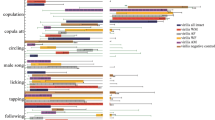Abstract
The courtship behavior and the effects of courtship song in inter- and intraspecific crosses were studied in the four sympatric species of the Drosophila auraria complex: D. auraria, D. biauraria, D. subauraria, and D. triauraria. Orientation, tapping, and vibration (the repertoires of male courtship) were observed in both inter- and intraspecific crosses, suggesting that signals from heterospecific females were enough to elicit such male behaviors. The crossability tests with wingless or winged heterospecific males (tests for wing effects) revealed that winged heterospecific males copulated less than wingless ones in all four species but not all the pairwise cases. Since the crossability tests with aristaless females (deaf) or normal females showed essentially the same results as the tests for wing effects, we concluded that the sound produced by wing vibration plays an important role and that the wing movement itself is less important. These findings suggest that courtship songs are of great importance in mate discrimination and the sexual isolation between the species of this complex.
Similar content being viewed by others
REFERENCES
Bennet-Clark, H. C., and Ewing, A. W. (1969). Pulse interval as a critical parameter in the courtship song of Drosophila melanogaster Anim. Behav. 17: 755–759.
Bixler, A., Jenkins, J. B., Tompkins, L., and McRobert, S. P. (1992). Identification of acoustic stimuli that mediate sexual behavior in Drosophila buskii (Diptera: Drosophilidae). J. Insect. Behav. 5: 469–478.
Burnet, B., Connolly, K., and Dennis, L. (1971). The function and processing of auditory information in the courtship behaviour of Drosophila melanogaster. Anim. Behav. 19: 409–415.
Cobb, M., and Jallon, J.-M. (1990). Pheromones, mate recognition and courtship stimulation in the Drosophila melanogaster species subgroup. Anim. Behav. 39: 1058–1067.
Crossley, S. A., and Bennet-Clark, H. C. (1993). The response of Drosophila parabipectinata to simulated courtship songs. Anim. Behav. 45: 559–570.
Ewing, A. W. (1964). The influence of wing area on the courtship behaviour of Drosophila melanogaster. Anim. Behav. 12: 316–320.
Ewing, A. W. (1983). Functional aspects of Drosophila courtship. Biol. Rev. 58: 275–292.
Doi, M., Nemoto, T., Nakanishi, H., Kuwahara, Y., and Oguma, Y. (1997). Behavioral response of males to major sex pheromone component, (Z, Z)-5,25-hentriacontadiene, of Drosophila ananassae females. J. Chem. Ecol. 23: 2067–2078.
Grossfield, J. (1968). The relative importance of wing utilization in light dependent courtship in Drosophila. Univ. Texas Publ. 6818: 147–156.
Hoikkala, A., and Aspi, J. (1993). Criteria of female mate choice in Drosophila littoralis, D. montana, and D. ezoana. Evolution 47: 768–777.
Jallon, J.-M. (1984). A few chemical words exchanged by Drosophila during courtship and mating. Behav. Genet. 14: 441–478.
Kimura, M. T. (1987). Habitat differentiation and speciation in the Drosophila auraria species-complex (Diptera, Drosophilidae). Kontyû 55: 429–436.
Kurokawa, H. (1960). Sexual isolation among the three races, A, B, and C of Drosophila auraria. Jpn. J. Genet. 35: 161–166.
Kurokawa, H., Oguma, Y., and Tachibana, N. (1982). Sexual isolation among four species of D. auraria complex. Dros. Inform. Serv. 58: 98–99.
Kyriacou, C. P., and Hall, J. C. (1982). The function of courtship song rhythms in Drosophila. Anim. Behav. 30: 794–801.
Liimatainen, J., Hoikkala, A., Aspi, J., and Welbergen, Ph. (1992). Courtship in Drosophila montana: The effects of male auditory signals on the behaviour of flies. Anim. Behav. 43: 35–48.
Manning, A. (1959). The sexual isolation between Drosophila melanogaster and Drosophila simulans. Anim. Behav. 7: 60–65.
Manning, A. (1967). Antennae and sexual receptivity in Drosophila melanogaster females. Science 158: 136–137.
Narda, R. D. (1966). Analysis of the stimuli involved in courtship and mating in D. malerkotliana (Sophophora, Drosophila). Anim. Behav. 14: 378–383.
Nemoto, T., Doi, M., Oshio, K., Matsubayashi, H., Oguma, Y., Suzuki, T., and Kuwahara, Y. (1994). (Z, Z)-5,27-Tritriacontadiene: Major sex pheromone of Drosophila pallidosa (Diptera; Drosophilidae). J. Chem. Ecol. 20: 3029–3037.
Noether, G. E. (1991). Introduction to Statistics: The Nonparametric Way, Springer-Verlag, New York.
Noor, M. A. (1995). Speciation driven by natural selection in Drosphila. Nature 375: 674–675.
Oguma, Y., Kurokawa, H., Akai, S. M., Tamaki, H., and Kajita, J. (1987). Interspecific differences in some courtship behavioral properties among the four species belonging to the Drosophila auraria complex. Zool. Sci. 4: 889–896.
Oguma, Y., Nemoto, T., and Kuwahara, Y. (1992). (Z)-11-pentacosene is the major sex pheromone component in Drosophila virilis (Diptera). Chemoecology 3: 60–64.
Oguma, Y., Jallon, J.-M., Tomaru, M., and Matsubayashi, H. (1996). Courtship behavior and sexual isolation between Drosophila auraria and D. triauraria in darkness and light. J. Evol. Biol. 9: 803–815.
Spieth, H. T. (1952). Mating behavior within the genus Drosophila (Diptera). Bull. Am. Mus. Nat. Hist. 99: 395–474.
Tomaru, M., and Oguma, Y. (1994). Differences in courtship song in the species of the Drosophila auraria complex. Anim. Behav. 47: 133–140.
Tomaru, M., Matsubayashi, H., and Oguma, Y. (1995). Heterospecific inter-pulse intervals of courtship song elicit female rejection in Drosophila biauraria. Anim. Behav. 50: 905–914.
Tompkins, L., Hall, J. C., and Hall, L. M. (1980). Courtship-stimulating volatile compounds from normal and mutant Drosophila. J. Insect Physiol. 26: 689–697.
Zar, J. H. (1984). Biostatistical Analysis, 2nd ed., Prentice-Hall, Englewood Cliffs, NJ.
Author information
Authors and Affiliations
Rights and permissions
About this article
Cite this article
Tomaru, M., Matsubayashi, H. & Oguma, Y. Effects of Courtship Song in Interspecific Crosses Among the Species of the Drosophila auraria Complex (Diptera: Drosophilidae). Journal of Insect Behavior 11, 383–398 (1998). https://doi.org/10.1023/A:1020954731063
Issue Date:
DOI: https://doi.org/10.1023/A:1020954731063



